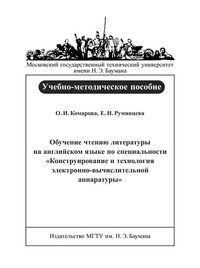Обучение чтению литературы на английском языке по специальности «Конструирование и технология электронно-вычислительной аппаратуры». Часть 3
Покупка
Тематика:
Английский язык
Год издания: 2010
Кол-во страниц: 38
Дополнительно
Вид издания:
Учебно-методическая литература
Уровень образования:
ВО - Бакалавриат
Артикул: 840511.01.99
Пособие состоит из двух тематических разделов: первый включает тексты о технологии CMOS, второй — о нанотехнологиях. Отдельно предлагаются тексты для ознакомительного чтения и краткого изложения содержания прочитанного. Тексты представляют собой статьи (или извлечения из статей) англоязычных авторов. Пособие содержит также упражнения на понимание текста, отработку и закрепление лексико-грамматических конструкций, развитие навыков устной речи. Для студентов 4-го курса, обучающихся по специальности «Конструирование и технология электронно-вычислительной аппаратуры».
Тематика:
ББК:
УДК:
ОКСО:
- ВО - Бакалавриат
- 00.03.02: Иностранный язык
- 11.03.03: Конструирование и технология электронных средств
ГРНТИ:
Скопировать запись
Фрагмент текстового слоя документа размещен для индексирующих роботов
Московский государственный технический университет имени Н. Э. Баумана О. И. Комарова, Е. И. Румянцева Обучение чтению литературы на английском языке по специальности «Конструирование и технология электронно-вычислительной аппаратуры» Учебно-методическое пособие Часть 3 Москва Издательство МГТУ им. Н. Э. Баумана 2010
УДК 802.0 ББК 81.2 Англ.-923 К63 Комарова О. И. К63 Обучение чтению литературы на английском языке по специальности «Конструирование и технология электронно-вычислительной аппаратуры»: учеб.-метод. пособие / О. И. Комарова, Е. И. Румянцева. — ч. 3. — М.: Изд-во МГТУ им. Н. Э. Баумана, 2010. — 36, [2] с. : ил. Пособие состоит из двух тематических разделов: первый включает тексты о технологии CMOS, второй — о нанотехнологиях. Отдельно предлагаются тексты для ознакомительного чтения и краткого изложения содержания прочитанного. Тексты представляют собой статьи (или извлечения из статей) англоязычных авторов. Пособие содержит также упражнения на понимание текста, отработку и закрепление лексико-грамматических конструкций, развитие навыков устной речи. Для студентов 4-го курса, обучающихся по специальности «Конструирование и технология электронно-вычислительной аппаратуры». УДК 802.0 ББК 81.2 Англ.-923 c⃝ МГТУ им. Н. Э. Баумана, 2010
Предисловие Настоящее пособие предназначено для студентов седьмого семестра, обучающихся по специальности «Конструирование и технология электронно-вычислительной аппаратуры». В пособии представлены оригинальные тексты, по степени трудности соответствующие экзаменационным текстам. Пособие состоит из трех тематических разделов: первый посвящен традиционным технологиям, второй — нанотехнологиям, третий включает тексты для ознакомительного чтения и краткого изложения (rendering). Каждый текст, предназначенный для чтения и перевода, сопровождается упражнениями на отработку лексико-грамматических конструкций и повторение материала, вызывающего наибольшие трудности на экзамене. Студенты должны научиться не только опознавать и понимать соответствующие лексико-грамматические конструкции, но и употреблять их в речи. За упражнениями на повторение и активизацию навыков устной речи следуют вопросы к тексту — это финальная стадия освоения текста, подводящая к монологическому высказыванию. Завершает работу над материалом устное изложение основных положений текста. Текстам из уроков Unit 1 и Unit 2 соответствуют тексты для ознакомительного чтения. Отметим, что авторы сознательно не стали давать вокабуляр к каждому тексту, так как предполагается, что студенты хорошо знакомы с лексикой по материалам предыдущих семестров. Содержание пособия позволяет студентам охватить широкий спектр информации по своей специальности, усовершенствовать навыки, умения и знания в области английского языка и успешно подготовиться к экзамену. 3
Unit 1. CMOS Technology 1. Read and translate the text. Text 1 The Importance of Moor’s Law The performance of integrated circuits has been improving exponentially for more than thirty years. In the next few years, the industry must overcome several technological challenges to sustain this pace of improvement. The remarkable characteristic of transistors that lies under the rapid growth of the information technology industry is that their speed increases and their cost decreases as their size is reduced. The transistors manufactured today are 50 times faster and occupy less than 1 % of the area of those built 20 years ago. It seems intuitively obvious that continued reduction of the area of a transistor by a factor of 2 every three years cannot be sustained forever. The predicted “limit” has been dropping at nearly the same rate as the size of the transistors. The accuracy of a prediction of the future of CMOS technology is therefore not likely to be very great. However, the key principles underlying the evolution of CMOS technology can give us some insight into the future. A recent research pointed out that the particular transistors in dominant use today (complementary p-type and n-type field-effect transistors, called CMOS) will soon have a lower rate of performance increase as their size is reduced. It is concluded that the current rate of transistor performance improvement can be sustained for another 10 to 15 years, but only through the development of new materials and transistor structures. In addition, a major change in lithography will be required to continue size reduction. Memory technology for DRAM products is similarly reaching a major hurdle and requires a new architecture to move beyond 8 Gb levels. The most common description of the evolution of 4


